
Clown Moshe Cohen at the memorial service for Bruce (U. Utah) Phillips

Clown Moshe Cohen at the memorial service for Bruce (U. Utah) Phillips
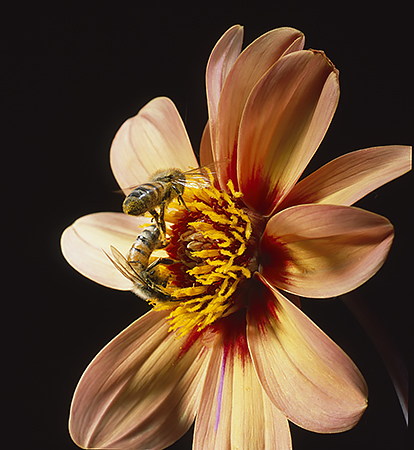
F32 and BEES There #2
Boris in one of his comments on Folio A asked for more detail on the Macrobox, which is given here:
The Macrobox is based on a contraption I purchased years ago from John Hart of Colorado. It was designed to hold 2 cameras at 90 degrees to each other, and both cameras were aimed at a 50/50 mirror (aka a beamsplitter) which is at a 45 degree angle. One camera shoots THROUGH the mirror, while the other shoots at the reflection.
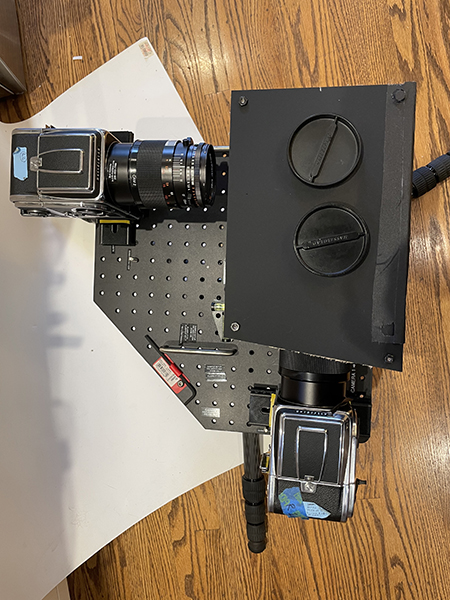
Overhead view of the Macrobox
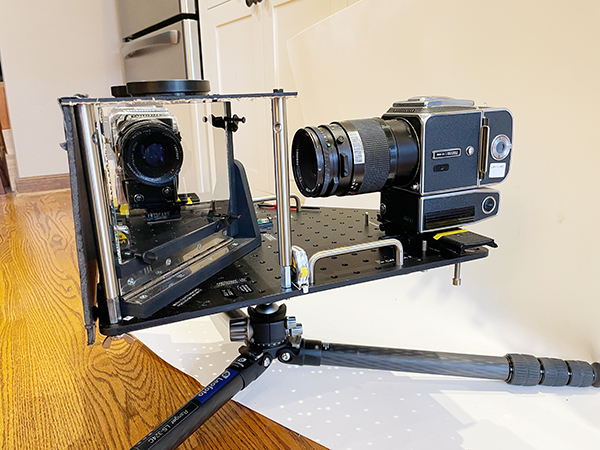
Side view of the Macrobox
In the sideview picture you can see the beamsplitter on the left side of the rig. If you look carefully at the mirror, you can see both cameras.
The cameras are individually mounted on sliders so they can be slid into position. Additionally, the Macrobox is normally mounted on a heavy-duty Velbon macro slider, to help with making fine adjustments to the positioning.
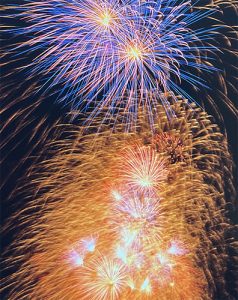
End of the fireworks show where the pyrotechs pull out all the stops
As the Flying Karamazov Brothers would say as they approached the end of their performance, “And now, the part of the show you’ve all been waiting for. The Finally.”
End of the fireworks show where they pull out all the stops.
There is a strange set of blinking lights running through the middle of the photo. Maybe a drone?
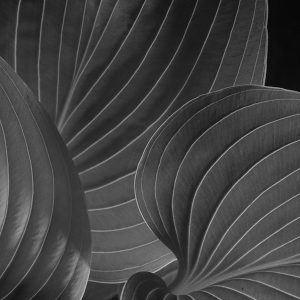
Hosta leaf patterns in black and white
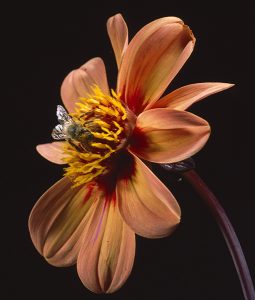
Close up shot of a honeybee on a dahlia
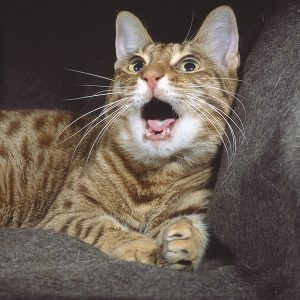
Keep it down up there, Willya?
One of the reasons I wanted, and built, this Macrobox was to capture shots of Tess in MF3D. I knew it wouldn’t be an easy pursuit because the moment I started doing something she would be all over it. “No, Tess, I want you *in front* of the camera. Not *on* the camera.” That sort of thing.
I was able to catch her in a quiet moment when the camera and strobes had been pre-set for her position. I like to think that in this shot she is hollering at some kids upstairs to be quiet. In fact I caught her in mid yawn.
This whole set could be titled “Adventures Near and Far.”

Bee Good #4
This was shot in August of 2020. Lots of the technical details are listed on the slide mount. One detail is listed incorrectly—the extension is 56mm and not 57. Cameras were triggered with the same wired trigger that I’ve used for fireworks. I like the look of the stamen in this shot—each one looks like a nuclear warhead. Using the macrobox, I was able to get a shot like this as well as shots of my cat Edison that circulated last round. But a total PITA to set up and use.
Meanwhile, a new friend of mine had opened my eyes to some Hasselblad equipment I was unaware of— things like bodies with built-in motor drives and wired remotes. I picked up a couple of the motorized bodies, but they were too big for the macrobox. That’s when the quest for a new macrobox began in earnest. By the end of September I had ordered an optical breadboard from Baselab Tools, which was to be the platform for my new toy.
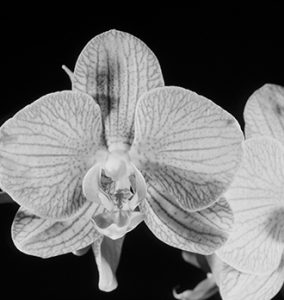
DR5 Orchid

Takin’ It To ‘Z!’
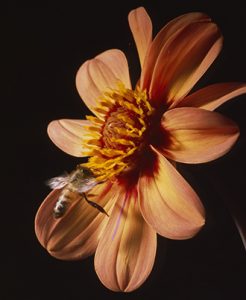
F32 and BEE There!
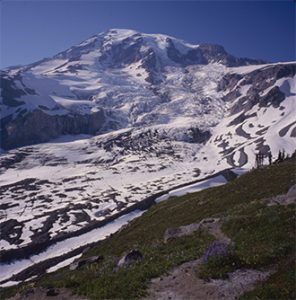
Rivers of Ice

Next Volcano Over

Mountain View
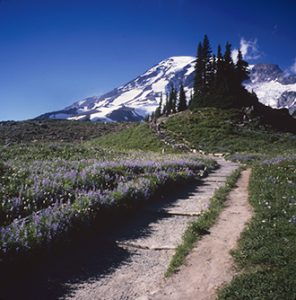
Hikers On The Trail
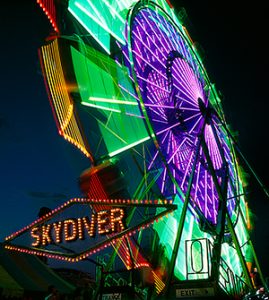
4 From Bob Venezia
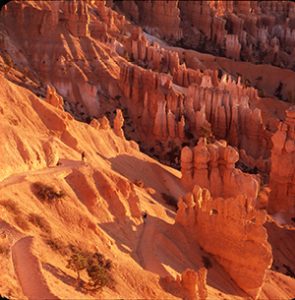


Timing was very unfortunate this year. I blame the Coronavirus. I received 2 folios within days of my state being identified as one of the world’s hotspots. The problem was compounded when several of my coworkers were ordered home because of potential exposures to the virus. For a while I was doing the work of 5 people. Even though by now there are 4 of us doing the work of 5, I’ve still been working long hours and not getting enough rest.
Sorry to have held onto the folio for so long. I’ll try to add some context to the photos in the coming days.
Skydiver is among my all-time favorite carnival ride shots. It’s the only time I captured the intermittent movement of this ride while it was loading. (My other captures of the ride show a more boring seamless disk when the ride was in full motion.
Photographers Playground is a slight hyperstereo shot at Bryce Canyon. At the time I was cursing these people who were messing up my nature shot. But clearly I ‘m an idiot, as you can see that they make the shot. Shot with Hasselblads at about 18 inches separation.
Fireworks (Sorry, I’ve already sent off the folio and don’t remember the exact title) is another of my hyper shots with forty feet separation.
And Edison Advances is shot with twin Hasselblads in a macrobox with a beamsplitter.
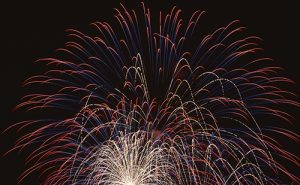
Independence Day fireworks over Seattle’s Lake Union
Taken with twin Hasselblad 500Cs spaced 40 feet apart and triggered with an ingenious device created by my good friend James Baker. The photo is taken from James’ roof. There will be no public fireworks show in Seattle in the year of 2020. But next time I shoot them I expect to be able to trigger the cameras wirelessly, using motorized film winders. Looking forward to that!
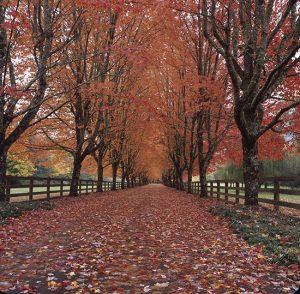
Entrance to Rockwood Farm in Snoqualmie, Washington
A popular stop for photographers in the fall is the entrance to Rockwood Farm in Snoqualmie, Washington, to the tremendous annoyance of the locals. Dozens of people stand at the entrance and spill out into the street. There’s a wrought iron gate I’m shooting through in this shot. I do wish I’d underexposed it a bit more for richer color.
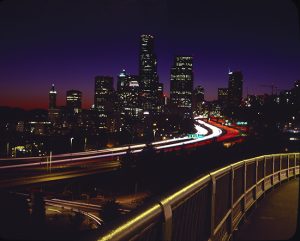
Seattle Skyline from the Jose Rizal Bridge
I’m including this photo because I think it demonstrates a point about composition and fusion. The rail on the bridge is too close in the image, but It works because the line of trees behind it have turned to featureless black and have separated the railing from most of the rest of the shot. I didn’t do that intentionally. I’m not that smart! (There is a small stretch of road that meets the railing that you can see in one image and not the other). The point is that the darkness of the trees act as a separator making it like 2 photographs — the close railing and the far city, so it’s not so difficult to fuse. If there had been a close vertical element (like a tall signpost) that passed through both the near and far parts of the image it couldn’t have worked.
Some notes about this image: The Jose Rizal Bridge is a favorite spot for photographers, and you can imagine why. You need a long exposure to get traffic trails, but the bridge bounces horribly when the frequent buses pass by, so you need to time your shots to avoid them. The image suffers from lens flare that could have been avoided had I been more attentive. And the railing is painted with the ugliest of insitutional green paint, but under the vapor streetlights it looks like solid gold!